Have you ever wondered where the innovation behind the skincare products begins? The answer often lies in a specialized setting, a cosmetic laboratory.
With years of experience in providing actionable insights into the cosmetics industry, you can trust us to deliver expert perspectives and industry-leading advice.
The role of a cosmetic laboratory is not merely confined to research and development; it serves as the nucleus of quality, efficacy, and sustainability in skincare solutions.
In this guide, you will discover the critical aspects that make a cosmetic laboratory indispensable to your brand, from formulation to packaging and regulatory compliance.
Read on to explore how these laboratories are shaping the future of cosmetics.
1. The Role of Cosmetic Laboratories
According to ISSUU, cosmetic Laboratories play a pivotal role in the development and innovation of beauty and skincare products. Through meticulous research and experimentation, they formulate products that cater to diverse skin types, concerns, and preferences, ensuring safety and efficacy for consumers.

These laboratories are responsible for ensuring that cosmetic products adhere to stringent regulatory and industry standards. They conduct a variety of tests, from stability and patch tests to microbiological analysis, ensuring that products are both safe for use and of high quality.
Beyond formulation and testing, cosmetic laboratories also engage in sustainable practices, sourcing ethical ingredients, and devising environmentally-friendly packaging solutions. Their work not only enhances beauty but also ensures the well-being of the planet and its inhabitants.
2. Importance of Research in Cosmetics
Research is the cornerstone of advancements in the cosmetic industry, enabling the creation of products that are more effective, safe, and tailored to individual needs. For example, with scientific investigations, researchers uncover novel ingredients, develop innovative formulation techniques. This ensures that products deliver the promised benefits while minimizing potential side effects.

Furthermore, as consumers become more conscious about the products they use, research helps address concerns related to sustainability, ethical sourcing, and environmental impact. By investing in research, cosmetic companies can meet evolving consumer demands and adhere to regulatory guidelines. For a long-term viability and reputation of their brands in the marketplace.
3. The Cosmetic Formulation Process
The creation of a cosmetic product is a meticulous blend of art and science, requiring both creativity and technical expertise. Here’s a breakdown of the cosmetic formulation process:
Step#1 Concept Development
This is the initial brainstorming stage where the product’s purpose, target audience, and key benefits are defined. Ideas may be influenced by market trends, consumer demands, or technological advancements. This concept provides a blueprint for the rest of the formulation process.
Step#2 Ingredient Selection
Based on the product concept, chemists select active and auxiliary ingredients. For instance, considering the desired properties, compatibility, and safety of each ingredient. This stage often involves researching and sourcing high-quality materials that align with the product’s goals.
Step#3 Prototyping and Formulating
Chemists create small batches of the product, experimenting with different concentrations and combinations of ingredients. The goal is to achieve the desired texture, stability, and efficacy. Multiple prototypes may be created before finalizing a formula.
Step#4 Safety and Stability Testing
Once a formula is established, it undergoes rigorous testing. This ensures the product is safe for human use, free from harmful pathogens, and has a satisfactory shelf life. Tests might include patch tests on the skin, microbial contamination checks, and monitoring product stability under various conditions.
Step#5 Packaging and Final Quality Control
The finished product is packaged into its final containers, keeping in mind both aesthetics and functionality. The packaging often complements the product’s branding and marketing strategy. Before shipping, a final quality control check ensures that the product meets all specifications and standards.
4. Regulatory Compliance
Regulatory bodies worldwide set guidelines and standards that cosmetic laboratories must adhere to, ensuring products are safe for consumers and consistent in quality. Let’s explore these compliance:
FDA Guidelines
- Ingredient Review: The FDA mandates that all cosmetic ingredients be substantiated for safety. While it doesn’t approve each ingredient, the responsibility is on manufacturers to ensure that their products are safe when used as directed.
- Labeling Standards: All cosmetics should have accurate labeling, including ingredient lists in descending order of quantity. Misbranding or the omission of ingredients can lead to product recalls or legal action.
- Adverse Event Reporting: Cosmetic manufacturers are encouraged to report any adverse consumer reactions to the FDA. This ensures that potential safety concerns are addressed promptly.
- Good Manufacturing Practices (GMP): Though not mandated, the FDA provides GMP guidelines for cosmetics. These practices ensure consistent product quality and safety through sanitation, processing, packaging, and holding.
International Regulations
- EC No. 1223/2009: This is a central legal framework for the European Union, ensuring the safety of cosmetic products. Products must have a detailed safety assessment and be registered in the EU Cosmetic Products Notification Portal before being marketed.
- ISO 22716: This is an international standard detailing the Good Manufacturing Practices for cosmetics. It provides guidance on producing, controlling, storing, and shipping cosmetic products, ensuring a consistent global standard for cosmetic safety and quality.
- ASEAN Cosmetic Directive (ACD): Established by the Association of Southeast Asian Nations, harmonizes cosmetic regulations among its member states. It requires product notification before marketing and sets guidelines on prohibited and restricted substances in cosmetics.
| Regulatory Body/Standard |
Aspect |
Description |
Implication |
| FDA Guidelines |
Ingredient Review |
All cosmetic ingredients must be substantiated for safety. |
Manufacturers are responsible for ensuring product safety when used as directed. |
| Labeling Standards |
Cosmetics must have accurate labeling, including ingredient lists in descending order of quantity. |
Misbranding or omission can lead to recalls or legal action. |
| Adverse Event Reporting |
Manufacturers should report adverse consumer reactions. |
Ensures prompt addressing of potential safety concerns. |
| Good Manufacturing Practices (GMP) |
Guidelines provided for consistent product quality and safety. |
Covers sanitation, processing, packaging, and holding. |
| EC No. 1223/2009 |
EU Safety Standards |
Central legal framework for the European Union ensuring cosmetic safety. |
Products need safety assessment and registration in the EU Cosmetic Products Notification Portal. |
| ISO 22716 |
Good Manufacturing Practices |
International standard for cosmetic production, control, storage, and shipping. |
Sets a global standard for cosmetic safety and quality. |
| ASEAN Cosmetic Directive (ACD) |
Harmonized Regulations |
Harmonizes cosmetic regulations among ASEAN member states. |
Requires product notification and sets guidelines on substances in cosmetics. |
5. Cosmetic Lab Safety Measures
Safety in cosmetic laboratories ensures the well-being of the professionals working within. By implementing strict safety measures, labs can maintain a productive environment while minimizing risks.
- Proper Personal Protective Equipment (PPE): According to BETAFIT, PPE protect against chemical splashes, spills, and other potential hazards. Lab workers must wear appropriate PPE, including lab coats, gloves, and safety goggles.
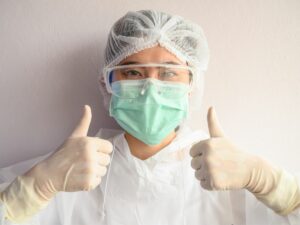
- Ventilation Systems: Proper ventilation removes fumes and vapors from the lab environment. It ensures that workers aren’t exposed to potentially harmful airborne substances and maintains good air quality.
- Material Safety Data Sheets (MSDS): Every chemical used should have an associated MSDS readily accessible. It provides vital information about the chemical’s properties, hazards, handling, and disposal methods.
- Chemical Storage Protocols: Chemicals must be stored according to their compatibility, usually in designated, well-labeled containers and cabinets. This prevents cross-contamination, degradation, and reduces the risk of accidental chemical reactions.

- Emergency Equipment: Laboratories should be equipped with emergency eyewash stations, safety showers, and fire extinguishers. These tools are crucial for immediate response to accidental spills, splashes, or fires.
- Regular Training and Drills: All lab personnel should undergo periodic safety training and participate in emergency drills. This ensures they’re well-versed in protocols, aware of potential risks, and can act quickly in emergencies.

6. Lab Equipment and Technology in Cosmetic Laboratories
Modern cosmetic laboratories are equipped with state-of-the-art equipment and technology to ensure precision, consistency, and efficacy in product formulation. Here are the tools that involves in encompases a cosmetic laboratory:
Microscope
A staple in almost every lab, microscopes allow researchers to closely examine cosmetic formulations at a cellular level. They can identify the structure of emulsions, detect any microbial contamination, and analyze the distribution and size of particles. I can attest that its use is pivotal in ensuring the texture and safety of products.

Centrifuge
Used for separating substances of different densities, a centrifuge is essential for stability testing in cosmetics. By rapidly spinning samples, formulators can determine if products will separate over time or under certain conditions. It aids in predicting a product’s shelf-life and performance.
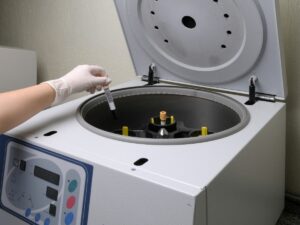
pH Meter
Maintaining the correct pH level in cosmetic products ensures their efficacy and safety. A pH meter accurately measures the acidity or alkalinity of a product, helping formulators make adjustments to ensure the product is skin-compatible and remains stable.

Viscometer
This instrument measures the viscosity or thickness of a cosmetic formulation. From my experience, by understanding a product’s viscosity, formulators can perfect its spreadability, feel, and application. It’s especially crucial for products like lotions, creams, and gels to ensure they have the desired consistency.

7. Product Development Pipeline
This multifaceted journey is shaped by scientific research, market insights, and consumer needs. Here are the stages that ensures the end product is both innovative and market-ready:
- Market Research & Idea Generation: By analyzing consumer feedback, reviewing competitor products, and staying updated with global beauty trends, brands conceptualize new product ideas that cater to identified needs.
- Conceptualization & Planning: This might involve creating mood boards, outlining product benefits, and defining target demographics. At this stage, preliminary budgets are established, and timelines are set for the subsequent stages of development.
- Formulation & Development: Nako Cosmetic’s chemists and formulators experiment with different ingredients and techniques to create the desired prototype. It involves selecting active ingredients, ensuring compatibility, and achieving the desired texture, scent, and efficacy.
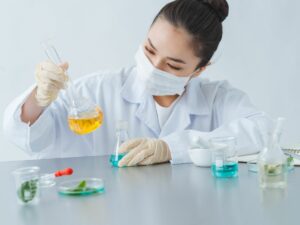
- Testing & Safety Evaluation: This includes dermatological tests, stability checks, and sometimes even consumer trials. With the global move towards cruelty-free products, in-vitro tests are becoming more prevalent.
- Marketing & Launch Strategy: Marketing team develop branding strategies, advertising campaigns, and distribution plans. This stage often involves creating promotional materials, securing retail partnerships, and planning launch events.

8. Cosmetic Testing Procedures
These procedures are governed by regulatory bodies and involve a series of scientifically controlled tests that analyze various aspects of a cosmetic formulation. Here’s a concise overview of cosmetic testing procedures:

Step#1 Safety Assessment
This initial step involves rigorous testing to ensure the product is safe for human use. It includes patch tests to check for irritants or allergens, and in vitro tests to replace traditional animal testing methods, ensuring the product causes no harm when applied to skin or hair. The safety assessment also examines the potential for adverse effects over both short-term and long-term use.
Step#2 Stability Testing
Stability tests are conducted to ensure that the cosmetic product maintains its intended functionality and form under varying conditions. This involves exposing the product to different temperatures, humidity levels, and light conditions to simulate various environments it might encounter. The objective is to ensure that the product’s efficacy, texture, color, and scent remain consistent throughout its shelf life.
Step#3 Performance Evaluation
Here, the product undergoes tests to confirm it delivers on its promises, whether it’s moisturizing skin, providing sun protection, or offering long-lasting color. This might involve consumer trials where volunteers use the product, or lab tests that measure specific properties like hydration levels, color persistence, or UV protection capabilities. The goal is to ensure the product meets advertised claims and consumer expectations.
Step#4 Regulatory Compliance Testing
This step ensures that the product complies with regional and international cosmetic regulations. It involves verifying that the product’s ingredients are permissible and within allowed concentrations, that the label accurately reflects the contents and adheres to legal standards. This is crucial for legal marketability and to avoid future liabilities or recalls.
Each of these steps is crucial in verifying that the cosmetic product is not only effective but also safe and legal for consumer use, thereby protecting both the end-users and the integrity of the brand.
9. Ethical Considerations in Cosmetic Research
Balancing the promise of beauty with moral imperatives requires brands to engage thoughtfully with several ethical considerations. Below are the different ethical considerations to keep in mind:
- Animal Testing: Historically, cosmetics were tested on animals to determine product safety. Adopting cruelty-free practices and supporting in-vitro testing or computer simulations are progressive steps.
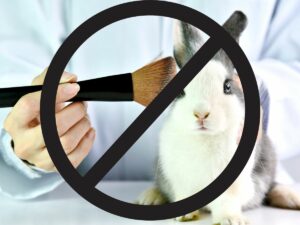
- Environmental Impact: The sourcing of ingredients can impact ecosystems and biodiversity. Sustainable sourcing ensures ingredients are harvested without depleting natural resources or harming habitats. Moreover, biodegradable packaging is gaining traction to reduce waste.
- Transparent Ingredient Listing: Consumers have the right to know what’s in the products they use. Honesty in ingredient disclosure helps users make informed decisions and avoids potential allergens or irritants. It’s about fostering trust and ensuring consumer safety.
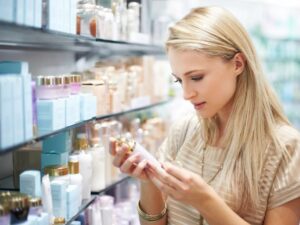
- Claims and Advertising: Over-hyping benefits or making unfounded claims is misleading. Authenticity in advertising helps maintain consumer trust and brand credibility.
Ethical practices not only protect consumers and the environment but also position a brand as socially responsible and forward-thinking.
10. Challenges Faced by Cosmetic Laboratories
These challenges range from formulation confusion and regulatory compliance to ever-evolving consumer expectations, all while maintaining product efficacy and safety. Let’s dive deeper into these challenges:

- Formulation Stability: Laboratories often grapple with ensuring that active ingredients remain effective and that the product doesn’t separate or degrade over time.
- Regulatory Compliance: Keeping up with these evolving standards, while ensuring products are compliant, is a perpetual challenge for labs. Just like those from Nako Cosmetic products adhere to stringent regional and global regulations.
- Sustainability Concerns: With rising environmental consciousness, labs face pressure to source sustainable ingredients and minimize ecological footprints. This shift necessitates rethinking formulations and packaging to align with green practices.
- Rapid Technological Advancements: As new technologies emerge, labs must quickly adapt to incorporate them. This requires constant upskilling and investment in new equipment, which can strain resources.
- Consumer Expectations and Trends: The beauty industry is trend-driven, and labs must promptly respond to ever-changing consumer demands. Balancing speed-to-market with product safety and efficacy is a delicate act laboratories strive to perfect.
Dive Deeper Into Our Resources
For some insightful reads, we’ve curated a list of recommended articles just for you:
Still haven’t found what you’re looking for? Don’t hesitate to contact us. We’re available around the clock to assist you.
Conclusion
Navigating the landscape of cosmetic laboratories is a challenge that requires specific knowledge and insight. This guide aims to equip you with the essential tools and information to make informed decisions that can drive your brand forward.
If you’re looking to scale your operations and require premium-quality cosmetic solutions, Nako Cosmetic is your go-to partner for excellence. To discover how the brand can elevate your product line, contact us today.














